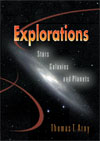 |  Explorations: Stars, Galaxies, and Planets Thomas Arny,
University of Massachusetts
The Sun, Our Star
OverviewThe Sun is a star, a dazzling, luminous ball of gas more than 100 times bigger
in diameter than the Earth. Although to the naked eye it gleams peacefully,
a telescope reveals the Sun's surface to be violently agitated, with rising
fountains of incandescent gas and a twisted magnetic field. Even greater violence
wracks its core. There, a nuclear furnace every second burns 600
million tons of hydrogen into helium, producing in one heartbeat the energy
of 100 billion nuclear bombs. How that energy is released and how the Sun manages
to hold itself together is the main theme of this chapter. We will begin by
describing the Sun: its radius, mass, and so on. Then we will discuss how the
crushing force of its gravity balances the explosive power in its core. Finally,
we will see how energy escaping from the core stirs its atmosphere into the
inferno we see. |
|



 2002 McGraw-Hill Higher Education
2002 McGraw-Hill Higher Education